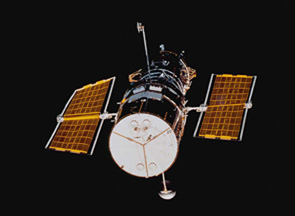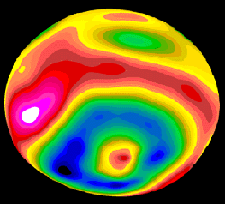Click on image for full size
NASA
Giant Crater Found on Asteroid Vesta!
News story originally written on September 9, 1997
A huge crater has been discovered on asteroid Vesta. The Hubble Space Telescope helped in making the discovery.
The crater really is gigantic when compared to the size of the asteroid Vesta. If Earth had a crater of proportional size, it would fill most of the Pacific Ocean!
Something large impacted Vesta a long time ago. Vesta lost over half a million cubic miles of rock during the impact. These rocks were thrown out into space. Scientists think that some of this rock fell to the Earth's surface. These rocks from outer space are what we call meteorites.
We don't know where most meteorites come from. So it is exciting for scientists to know that Vesta might be the source of some meteorites.
You might also be interested in:

The Hubble Space Telescope (HST) was one of the most important exploration tools of the past two decades, and will continue to serve as a great resource well into the new millennium. The HST found numerous
...more
It was another exciting and frustrating year for the space science program. It seemed that every step forward led to one backwards. Either way, NASA led the way to a great century of discovery. Unfortunately,
...more
The Space Shuttle Discovery lifted off from Kennedy Space Center on October 29th at 2:19 p.m. EST. The weather was great as Discovery took 8 1/2 minutes to reach orbit. This was the United States' 123rd
...more
A moon was discovered orbiting the asteroid, Eugenia. This is only the second time in history that a satellite has been seen circling an asteroid. A special mirror allowed scientists to find the moon
...more
Will Russia ever put the service module for the International Space Station in space? NASA officials want an answer from the Russian government. The necessary service module is currently waiting to be
...more
A coronal mass ejection (CME) happened on the Sun early last month. The material that was thrown out from this explosion passed the ACE spacecraft. The SWICS instrument on ACE has produced a new and very
...more
J.S. Maini of the Canadian Forest Service called forests the "heart and lungs of the world." This is because forests filter air and water pollution, absorb carbon dioxide, release oxygen, and maintain
...more















